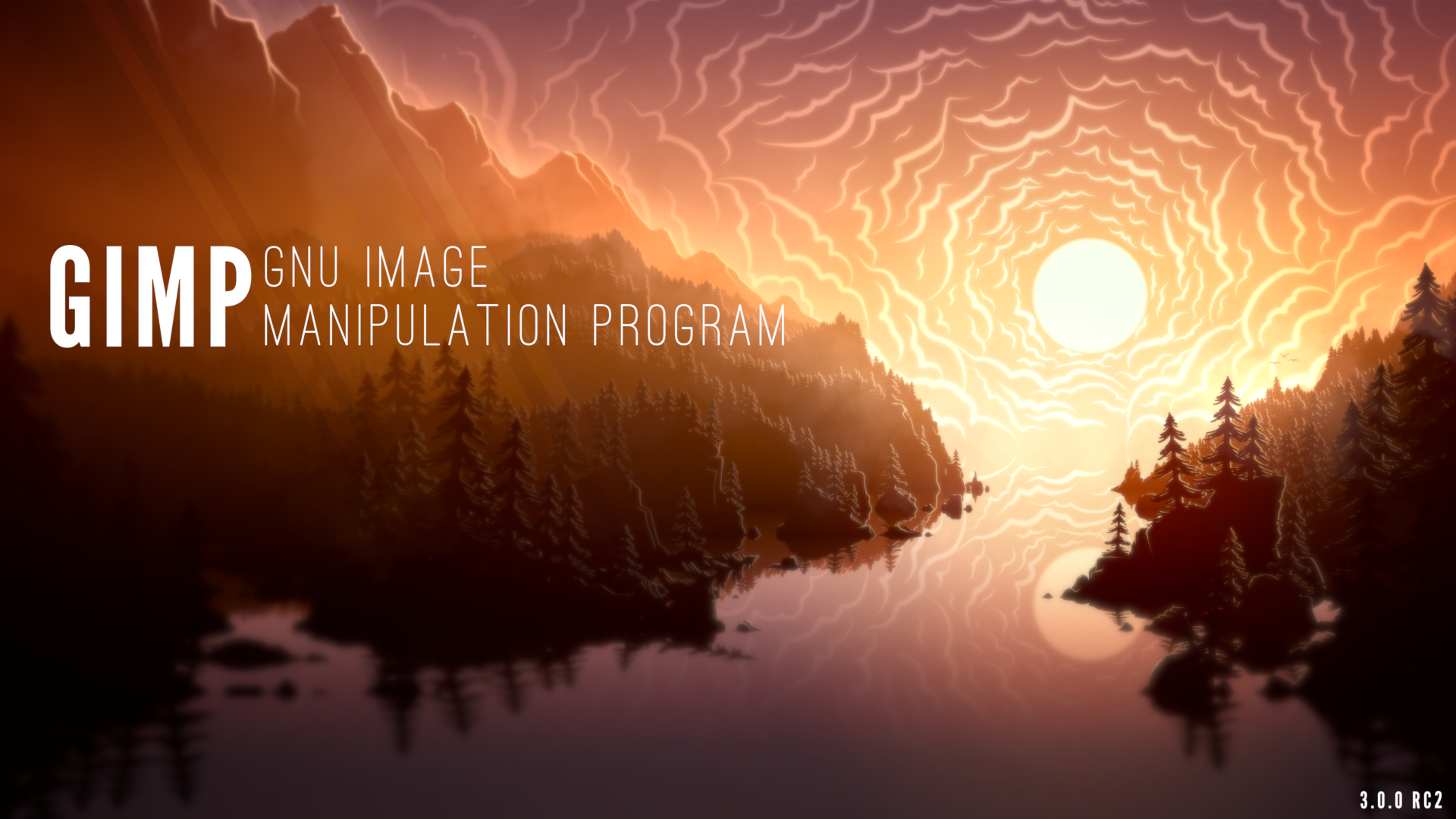- cross-posted to:
- foss@beehaw.org
- cross-posted to:
- foss@beehaw.org
Man, after decades, why does GIMP still have a marketing problem?
Just visit https://www.gimp.org/ and compare it to https://www.adobe.com/ca/products/photoshop.html
Just assume both did exactly the same thing and cost the exact same amount (free or otherwise). Which would you choose based on their website?
Why does GIMP (and pretty much all FOSS) have to be so secretive about their product? Why no screenshots? Why not showcase the software on their website?
It’s so damn frustrating that every FOSS app appears to be command line software, or assumed that the user knows everything about it already.
Devs, you might have a killer piece of software, but screenshots go a long way to help with gaining interest and adoption.
You’re welcome to contribute your experties.
I wish I could, but this is a systemic problem, not a problem with one individual project.
Is the mindset that anyone looking for open source, FOSS, or Linux stuff is already tech-savvy enough to know exactly what they are looking for based solely on a text description?
I think it’s more so that the kind of people contributing to these projects are on balance not that interested in doing the marketing work.
Do the operating systems the contributors use not have a screenshot function?
I mean, seriously, simply highlighting a few features would make a massive difference.
I speak for all projects, not just GIMP.
These projects are run by volunteers, they don’t have the unlimited budget for designers that Adobe does. And to be honest, it kinda seems like you’re just criticizing them for no good reason. Have you personally designed and built a website that doesn’t suck?
These projects are run by volunteers, they don’t have the unlimited budget for designers that Adobe does.
A few screenshots would be nice. Not asking them to make a high-production video intro shot on a cruise ship with RED cameras and featuring an A-list celeb.
And to be honest, it kinda seems like you’re just criticizing them for no good reason.
On the contrary. I want to see them reach a wider audience. I want to see FOSS, Linux, and other open-source projects become more accessible and widely available. For me, the way many of these projects present themselves is like gatekeeping to keep people away.
Have you personally designed and built a website that doesn’t suck?
Yes, but I won’t doxx myself, so there’s no proof I can give you.
Regardless, as a user and someone who wants to see open-source projects succeed, my comment should only be taken as constructive criticism.
On the contrary. I want to see them reach a wider audience. I want to see FOSS, Linux, and other open-source projects become more accessible and widely available
then contribute, it’s called “open source” for a reason or at least raise an issue where the maintainers can see? Not on some random link aggregation platform about an announcement?
is taking a screenshot that hard?
You can if you wish. You just choose not to. Like so many of us. If more did volunteer, the problem would disappear. It’s that simple.
Basically, yes.
I actually like the GIMP website homepage more than the one for photoshop.
Its simple and efficient. If I want to know more I would go to documentation or tutorials.
The photoshop site just looks like a random squarespace template with a bunch of stock photos.
If I want to know more I would go to documentation or tutorials.
See, that’s not normal, though. You shouldn’t need to “dig deeper” to find out what a product is or what it does.
The well-designed homepage should simply tell you that within seconds of visiting. Any additional clicks should only be to “learn more”, but not to learn about.
If this was an analogy, imagine a street lined with restaurants.
On one side you’ve got “Vinny’s Italian Pizzeria”, “Joe’s Burgers and Fries”, and “Mary’s Bakery and Treats”. Each has posters of what they sell posted on the windows, and a QR code to their online menu.
On the other you have “Sal’s Food”, “Frank’s More Food”, “Sal’s”. The windows are either covered in brown paper, or have stock images of “food”, but nothing specific about what they actually make. To learn more, you have to go inside, ask someone for a menu, wait for that menu, then have a look. But the menu lacks photos! You either have to know what they are describing to you in the menu, or you would have to have already dined there before.
Does the latter experience sound good? Because that’s how too many open-source projects present themselves, and it’s to the loss of the volunteer devs and their potential user base.
Yeah… I was expecting a much larger contrast. Give me the one that doesn’t start off with several popups.
I feel like the Adobe marketing is somewhat pointless. Anyone that has been in the target industries for any amount of time already know the deal.
GIMP is not Photoshop. They are not competitors. It’s a difficult transition. I’m not sure we should even bother drawing a comparison.
I’ve used Photoshop since 1992. I know, I’m old. I started using GIMP about four years ago. I recently got to the point where I can function.
Money and momentum is a motherfucker. Adobe has fuck you money. GIMP has volunteers. Those that don’t like their site should volunteer time or money.
Edit: fwiw I like the GIMP site better too.
I totally agree
Yeah, I never got into illustration or 3d art/animation, but I sure as hell know what Blender is!
FOSS projects are often labors of love.
Nobody who isn’t completely deranged loves marketing.
Me: Hello niece, what career will you embark on once college is over?
Niece: Marketing.
Me: [audibly] Ah, I see. [inaudibly] Where did our family go wrong???
Idk if GIMP has a marketing problem but I definitely agree that FOSS projects should add screenshots and a description of what the program does to their website and repo. It really annoys me when someone links a piece of software and it just doesn’t say what it does and there’s no screenshots that would make it easy for me to see what it looks like and how the UI is structured. When there’s no screenshots I’m rarely even interested in trying it out because, even with a description, I don’t really know what it is. Like, I wouldn’t be interested in a car based on only a description, I’d have to see a picture of it too.
Actually I would pick GIMP.
- Says what it is, an image editor.
- No popups and random interruptions.
- Not only AI editing examples which makes me thing the tool is AI only.
- An overview of the variety of major features it has rather than just AI editing.
- Links to helpful documentation rather than endless marketing pages that say nothing.
Really think only thing I would like to see is some screenshots and examples of using the tool, rather than just info on what it does. But the Photoshop page barely has this, just a few examples of the AI tools.
I would have to choose GIMP (in spite of this awful name) because that page loaded without javascript and the photoshop page requires me to enable javascript.
I know I’m being a bit facetious, here, but… Adobe can afford to hire full time front end devs and designers. FOSS projects can’t really compete with Adobe’s investors.
LOL. Brother, I get what you’re saying, but I think you missed the point. If Random User X is just looking for an image editor, and they are presented with a few options they know nothing about. Do you think they’re going to even bother with the one image editor that doesn’t have any screenshots?
Just another comparison, a little more relevant: https://www.rawtherapee.com/
You know EXACTLY what it is and what it does within about 2 seconds. That would be more than enough information for someone to at least make the effort to download the software.
If I recommend some software to someone, most normies I know would directly go on to youtube and check some guy using and reviewing a software. The “official website” wouldn’t even cross their mind.
In this day and age if a random user really wants something, they have a miriad of options to see what they’re about to use. Forums, Youtube, blog posts and so on.
If a user doesn’t even bother a bare , they’re better off not downloading random executables from the internet.
The website isn’t end all, be all of how users find a software demos. You seem to think a single website is enough for users to make their choices these days. It isn’t the 90s.
An informed user goes through that much effort. Most users are not informed and will do a quick search, download something that looks remotely what they think they need, and they’re done.
This is why it’s frustrating that some really good open-source software end up being lost in a sea of other stuff that was easier for someone to download, without doing a ton of research.
It doesn’t necessarily have to be a website, but a website should be “home base” for a software, company, etc. If not the official website, then the developer has less control over the presentation of their product, which would suck.
App stores are successful for a reason: they offer a quick, accessible means to find 1000s of apps or desktop software. And if an app has a poor description or piss poor screenshots, they are skipped very quickly.
The same applies to the UX and UI of an app or website. A poor experience can cause someone to uninstall it (or exit the page), even if it offers them the features they want/need.
Gimp doesn’t have a marketing problem. Its well known its just that not many people like it. It is not a nice program to use. I think gimp3 fixes a lot of the janky ui but I’ll have to try it out again
Yeah, every time I have ever tried Gimp, attempting to do anything felt like someone had purposefully been contrarian and made every operation work in the hardest and most confusing way.
And someone may say, “well, you just have to learn it!” OK, sure. Or I can use something that makes much more sense from the jump like Affinity Photo. (Yes, I know you have to pay for it, but it’s worth it. Yes, I know not everyone has the money to do so.)
this is exactly my opinion on it. one of my main gripes was the text rendering. if i needed to change some text i basically had to redo all of the work on any shadow or stroke as well, not just correct a spelling mistake or whatever. very excited to check out the new version.
It is not a nice program to use.
Holy hell. I felt like that 20+ years ago when I started using it… I’m surprised that it never got better, from the sound of it.
Progress just has been painfully slow. It just now got the update it should’ve had back then
Agree, however on clicking the photoshop link was first hit with 2 popups before I could see the page.
I mean, the Adobe website flashed me pop-ups about not being in the right location, about cookies - I would choose GIMP based on this.
I choose FOSS 90% of the time because they are not beholden to the same conventions that compel most for-profit products. A lot of the concerns I’m reading about readability, marketability, etc ring absolutely true for life-or-death for-profit ventures, but there are definitely people who don’t mind missing all of that stuff in exchange for good and decent software.
The goal, after all, is to be image editing software, not an advertisement.
Unless 3.0 has solved it, the gimp has a steep UI problem and a learning curve such that mass appeal on the website would be inappropriate anyway. I love it but I love it because I’ve been using it my whole life and know it very well. Foss in general struggles with useability due to a lot of hard to overcome problems - mainly, that by the time someone is ready to contribute to any given foss project, they’re already intimately familiar with its foibles and probably have strong opinions about what UX elements are sacred cows and should not be fixed.
I couldn’t agree more and I see it everywhere as well. It’s systemic.
Which would you choose based on their website?
Problem is, people on Lemmy are techies who might actually prefer the Gimp site. But any “normal” person would not.
Yeah I admit I kind of prefer the Gimp site. Are you saying Lemmy isn’t an accurate random sample of normal people in reality?
Yes, Lemmy is dominated by people with a certain propensity towards tech. You can’t use Lemmy users as a gauge for what is good UX I would say.
Open Source software is not a product that needs marketing.
The devs making Gimp gain literally nothing from you downloading and using it.
Stop applying capitalist logic to one of the few aspects of life that haven’t been monetized yet.Open Source software is not a product that needs marketing.
That’s highly debatable.
Surely, if nobody is using the software, then there’s no incentive to keep making it.
Marketing generates interest. Interest gets users. Users (hopefully) get donations and/or contributions to the project.
Even from a purely practical standpoint, why not be clear and avoid wasting people’s time as they try to figure out what exactly a project is about?
I’m not suggesting that GIMP take out Facebook ads. But my god, would a few screenshots kill the project?
Surely, if nobody is using the software, then there’s no incentive to keep making it.
Making a tool you or the company you work for need yourself, fun, learning, community, doing good, showing off, status, being remembered, (even if it’s just in a circle of 10 people)…
Marketing generates interest. Interest gets users. Users (hopefully) get donations and/or contributions to the project.
Irrelevant for the vast majority of open source projects, which will never be financially profitable.
why not be clear and avoid wasting people’s time as they try to figure out what exactly a project is about?
Maybe because the volunteers working on the project in their free time are programmers, not marketers or good communicators?
Also, they aren’t wasting anybody’s time by creating useful software and giving it away for free.I realize I’m being confrontational towards you, but this mindset of demanding things from people who literally give away free stuff with no strings attached rubs me the wrong way, every single time. And this mindset is much too prevalent, even to the point of harassing, insulting and threatening open source devs for choices they make in their projects.
The devs owe you nothing. If you don’t like what they do, simply don’t use it.
There are other options out there, but they may come with a $23/month price tag.You are right. I just checked out gimp.org, and…IS there a single image of the software on that site?
If they want new users, asking them to blindly download software without even a look or maybe a video of new features is not it.
Other programs like Photoshop lose money though. FOSS devs should just quit as they’re their own competition.
Idk I like the gimp page. Two clicks, and you’re into the tutorial on how to edit pictures. The first page gives you all you need to know: Image manipulation program.
adobe’s page otoh… Well after the first two popups, I gave up.
…
Alright, Second try and four popups later, I’m in. gotta admit the funny animations and the tools they show off are pretty nice
I think it’s because marketing is expensive and marketing people know that corporations have money to throw at them, and the moment they lower their prices for a FOSS project, they might not get their old revenue when working for a company that can definitely pay what they ask.
We need some sort of FOSM (Free and Open Source Marketing) that helps FOSS projects based on some sort of queue and whoever has recent changes that needs marketing.
I think it’s because marketing is expensive
Perhaps I should clarify what I mean by “marketing”. I’m not talking about spending tens of thousands of Facebook ads, or any ads, really.
A few screenshots on a product page would be more than enough for some projects. Highlight some key features. Generate interest.
It’s really low effort stuff that makes a huge difference.
These are all excellent ways someone can contribute to a project. Our project website has a repo anything can contribute to to make changes, even the blog entries are statically generated pages.
I mean, the name is a bigger problem than anyone seems to want to admit…
Majority of area in the world does not recognize it as negative thing.
Even for English, English itself is diverse language. Singaporean English, Indian English, Asian English, definitely not negative in all of them.
Forcing one standard of language as a universal is a bad precedent for language diversity.
Is it because in Linux the UI is so customisable that there’s no definitive ‘look’ to sell?
dont forget how they expect you to compile it. some projects offer a nice .msi for windows, a .whatever for mac, and then linux users just get a link to their github. i mean cmon.
“They” most of the times is solo devs and you can’t blame them for that. GIMP does have flatpak, appimages, etc.
deleted by creator
Incredible. This is one of those hard to believe moments.
It’s been 21 years since the release of GIMP 2.0.
It’s been more than 10 years since work on a majorly overhauled GIMP 3.0 was announced and initiated.
And it’s been 7 years since the last major release (2.10).
I can’t wait for the non-destructive text effects. After all these years of dealing with the fact applying drop shadows meant the text couldn’t be edited, at last it’s no longer an issue.
As a long time - pre version 2 - gimp user my first thought was “what, don’t be ridiculous” and now I dont know what to feel. Why would you do this to me personally
Version numbers are basically meaningless.
zero screenshots on the announcement page and zero screenshots on the homepage. Exactly what i expect from gimp lol
The UI looks the same lol
The layers are the big thing, but its hard to show because the final result looks the same anyways
Aw man i was hoping for a big ui upgrade like when blender released version 2.8 that now even cinema4d is copying.
I fear gimp truly doesnt care about its ui/ux because technically everything you want to do is possible as long as you learn the ways ans they dont care to attract an audience thats not die hard FOSS people. For example schools havent been able to use it because theyre so deadset on their nsfw name and schools cant have kids googling gimp with the pictures that will show up
they could have just called gims or gum
naming stuff is important
I fear gimp truly doesnt care about its ui/ux
Why, because its been the single most requested change by the GIMP community for 20+ years and its the one thing they refuse to address?? Dont be silly, its not like the devs are acting like the guy who makes Filezilla who has been steadfastly refusing to implement a ‘dark’ feature simply because he does think anyone wants it… oh wait
No self-respecting UI designer would ever want to work on that dinosaur of a codebase. The GIMP team is simply unable to do what Blender did, even if they made the UI their number one priority.
So in the end we got gimp 3 before GTA 6
We got gimp 3 before half life 3.
I opened it, changed brush, got a segmentation fault crash lmao
Isn’t C just wonderful?
It’s always the user’s fault. Why do think you could change the brush using an UI element!?

Already on flathub. Nice modern packaging world. https://github.com/flathub/org.gimp.GIMP
FUCK YES!!!
I’ve been waiting for this for years! Omg, what awesome news!!
I’ve been seeing quite a few posts about this, pretty funny that it all happened so fast.
Brilliant and huge congrats to the amazing people who worked on it. One silly question though, is the “new” Gimp logo supposed to look out of focus or are my eyes getting old?
I’ve only used GIMP a handful of times, so please forgive my ignorance – how does 3.0 compare to Krita or IbisPaint?
GIMP is generally geared towards photo-editing, so if you have an existing image, you can use GIMP quite well to e.g. cut out parts of it or to apply effects.
It’s not really geared towards digital painting or creating new images from scratch, like Krita and presumably IbisPaint are.
deleted by creator
If it’s non destructive now I might try to learn it.
Next. They should drop everything and solely focus on improving ux & ui . Every time I open gimp to try and get acclimated to it, I close it back out of frustration. Nothing is intuitive in that software. Not even the naming of the tools settings.
i mean its pretty good if you get used to it… i remember the shortcuts for all the major tools i use and it’s very quick and easy to use for me.
Nothing is intuitive in that software.
UI/UX is a very very difficult job. I’ve only ever known a few UI/UX artists that were any good, and OMFG, are they expensive.
You can’t just drop everything and focus on something where you don’t have domain experts. Not to presume too much about you, but that would be like saying you need to drop everything you’re doing and focus on brain surgery next year. UI/UX is art. It’s a very specific type of art that, unfortunately, doesn’t come easy for people. There are companies for hire that work professionally on UX/UI, but they’re not cheap either. Anyone can spot bad UX, but knowing how to fix it in a way that works for everyone, that’s nearly a unicorn.
I’ve been using gimp since it was released for daily driver projects.
I’ve been using Photoshop for about a decade when required for gigs.
I can get around either app pretty decently at this point.
If you drop any new user into either, they’ll be absolutely lost.
If you drop a seasoned Photoshop user into GIMP, they’ll not only be lost but be unable to use their vast array of plugins and macros and aren’t quite (but non-technically are) impossible for the average user to work on.
We can’t make Gimp Photoshop-like. We can make strides to improve Gimp, but it’s beyond reach for the current team. Maybe we can start a crowdfund to get a UX company to take a stab at it, but even at that we’d need buy in from the developers and it would likely be an incredibly large rework, not unlike the current one that took quite a long time.
@rumba @mtchristo To gently disagree with you here: UI/UX work is absolutely not art, and in fact, this painting of the profession as some artsy fairy-dust non-technical creative magic is a big part of the reason why FLOSS projects have trouble attracting designers—they don’t respect their work.
UI/UX makes broad use of scientific evidence as to how people see, perceive, and interact with things around them. Conducting studies is literally part of the job at large companies, and those who do not have the budget rely on resources like reports from the Nielsen Norman Group to get up to date information on topics such as how people’s eyes scan a page, how content influences this, effectiveness / interaction rates of different design patterns, et cetera.
Unfortunately for the odd designer who does wind up in a discussion on a merge request on GitLab, their expertise is often treated as a difference of creative opinion by developers who know nothing about basic design principles such as gestalt psychology.
The problem of poor UX in FLOSS can’t be attributed to a lack of talent; the fact is that FLOSS projects are not hospitable environments for designers, both technically and culturally. For a start discussions happen on GitLab et al, platforms which are confusing to people who aren’t developers. And then, whereas if a non-technical user started arguing with devs on matters they don’t understand they’d be booted from the discussion, devs who clearly don’t have even basic design knowledge get carte blanche to debate against designers (on design, not technical feasibility), and their positions are treated as equally valid because they see design expertise as art—a subjective matter of mere opinion.
If FLOSS devs want usable interfaces (and I’m not convinced many of them do) this is the problem that needs to be solved.
To gently disagree with you here: UI/UX work is absolutely not art,
UI without art is just a bunch of shitty buttons no one wants to press. Come to think of it, that’s one of the problems with Gimp. There is a UI, it’s just not a good one.
UX is arguably design. But most design departments would place UX as a mixed discipline.
scientific evidence as to how people see, perceive, and interact with things around them.
You’re describing Usability. This is, in fact, its own discipline that should direct both UX and UI.
The problem of poor UX in FLOSS can’t be attributed to a lack of talent; the fact is that FLOSS projects are not hospitable environments for designers, both technically and culturally.
That’s just saying it’s a lack of talent because FOSS teams are inhospitable. Blanket statements like that ring as a stereotype.
their expertise is often treated as a difference of creative opinion by developers who know nothing about basic design principles
The consumers of the product know nothing about basic design principles either. Does their opinion not matter either?
If FLOSS devs want usable interfaces (and I’m not convinced many of them do) this is the problem that needs to be solved.
So, forgive me if I’m reading too much between the lines, but what you’re saying here is if FLOSS wants better UI, they need to engage someone who says they’re an accomplished UI artist and blindly execute their vision even against their own impressions of the requested work?
Maybe there are reasons the FLOSS devs don’t want to sign up for that?
UI without art is just a bunch of shitty buttons no one wants to press.
You’re describing Usability. This is, in fact, its own discipline that should direct both UX and UI.
Disagree. I do not believe that the design of a button is art. Even things like the roundness of the corners have justifications that relate to usability, which is an inherent part of design, and it always has been. Visual hierarchy is usability. Type selection is usability. Gestalt theory is usability. The hanging punctuation in medieval manuscripts is usability. UI, UX, usability: It’s all just design. In fact, if you’re a “designer” who is regularly putting out work that doesn’t meaningfully consider usability, you may well be an artist instead!
That’s just saying it’s a lack of talent because FOSS teams are inhospitable. Blanket statements like that ring as a stereotype.
This is a thought-terminating cliché, but thanks for demonstrating my point by flatly negating my personal experience as a designer who does volunteer for FLOSS projects from time to time.
The consumers of the product know nothing about basic design principles either. Does their opinion not matter either?
This is a strawman. My point was not that no one’s opinion but that of a designer matters. My point was that when designers are making recommendations based on their knowledge and experience that relate to design problems, the opinions of people who do not have expertise on these matters should not be treated with equal weight.
So, forgive me if I’m reading too much between the lines, but what you’re saying here is if FLOSS wants better UI, they need to engage someone who says they’re an accomplished UI artist and blindly execute their vision even against their own impressions of the requested work?
Yea, again, this is not what I’m saying. If a designer says “hey, we should probably put that button here for X and Y reasons,” devs should have the humility to understand that, as a design professional, they probably have a reason for saying so that goes beyond ‘I think it looks nicer.’ That’s the cultural component. The technical component is that FLOSS projects need to meet designers where they are and not ask them to use platforms they’re likely not familiar with in order to participate.
I agree to disagree, have a good one.
It is essential that you explain exactly what you find unintuitive, otherwise -forgive me, but- this feedback is worthless. Make a bullet list, with captures, show how you would rename or rearrange things. Do your part !
forgive me, but- this feedback is worthless
Its not useless when literally 99% of the people who tried GIMP Over the past 25+ years have had the exact same reaction, pretending its not a thing its whats useless
It is worthless, in fact. Because it’s not actionable. Read what the above user said again :
Every time I open gimp to try and get acclimated to it, I close it back out of frustration. Nothing is intuitive in that software. Not even the naming of the tools settings.
Nothing in here is specific enough to do anything about it. Imagine you’re a developer, and you read this. What do you do ?
As users, we may not be able to program stuff, but we can do so much design work. Making mockups takes some time but it’s within our reach. Let’s all contribute to the best of our ability. If all a user can say is “Nothing is intuitive”, then their feedback can only be dismissed. Because it’s not actionable.
How many of those who have never used Photoshop would have the same reaction to Photoshop?
This is what always frustrates me when people complain about GIMP’s UI!
The common opinion is to “make it more like Photoshop”, but Photoshop is absolutely not beginner friendly - most of those people are just familiar with it already.
I remember being completely lost and constantly getting annoyed when I first started using Photoshop.
Don’t touch my workflow. Just because you couldn’t get acclimated to it, doesn’t mean no one did.
It finally happened!?!























